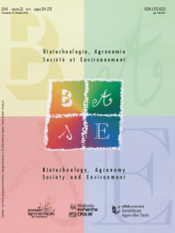Évaluation par les pairs
1. Vérifications et sélection
À la réception de l'article, le secrétariat de la revue adresse un accusé de réception à tous les auteurs. Si l'article respecte le présent guide des auteurs (longueur, titres, illustrations...), il est enregistré. Dans le cas contraire, le secrétariat demande une mise en conformité à l'auteur correspondant.
L'article fait ensuite l'objet d'une première sélection. Cette première lecture par le conseiller scientifique permet de vérifier si le manuscrit est recevable. Lors de cette étape, le conseiller scientifique vérifie l'originalité et l'intérêt du travail, la structure du manuscrit, les aspects éthiques ainsi que ses qualités scientifiques et rédactionnelles.
Pour les manuscrits soumis en anglais, la qualité de la langue est vérifiée par un bureau de traduction indépendant.
2. Validation
Tous les articles ensuite sont transmis au comité de rédaction. En fonction de l'avis du conseiller scientifique et du bureau de traduction, le comité de rédaction peut d’emblée décider de rejeter un article. Les articles jugés insuffisants lors de la sélection sont retournés à leurs auteurs avec la justification du rejet.
Les manuscrits validés sont soumis à au moins deux lecteurs.
La lecture s'effectue en « double aveugle ». Les auteurs ne savent pas qui lit le manuscrit et le nom des auteurs n'est pas transmis aux lecteurs. Un lecteur, s'il le souhaite, peut néanmoins être mis en relation avec l'auteur correspondant.
Le comité de rédaction se réserve le droit de sélectionner les lecteurs parmi ses propres évaluateurs ou dans la liste des suggestions de l'auteur. Il veille systématiquement à éviter tout conflit d'intérêt entre un lecteur et les auteurs de l'article. Le comité de rédaction vérifie, dans la mesure du possible, si les lecteurs sélectionnés ne sont pas trop proches d'un ou de plusieurs auteurs. Pour les articles dont au moins un des auteurs est affilié à l'ULg ou au Centre wallon de Recherches agronomiques, les lecteurs choisis n'émanent d'aucune de ces deux institutions.
Le comité de rédaction se réserve le droit de requalifier l'avis des lecteurs en fonction des différents commentaires. La décision sera soit :
- une acceptation de l'article ;
- une révision mineure (corrections de forme) ;
- une révision majeure (corrections de fond : objectifs, expérimentation, résultats et leur interprétation, discussion...) ;
- un rejet.
La décision est prise à la majorité des membres présents. Elle est notifiée à l'auteur correspondant. Il reçoit le manuscrit avec les commentaires et questions des lecteurs introduites dans le manuscrit et/ou sur une page séparée.
Un article rejeté ne peut pas être resoumis.
3. Révision
L'auteur dispose d'un délai de deux mois pour retourner son manuscrit corrigé. Passé le délai de deux mois, il reçoit un rappel. S’il ne réagit pas au rappel, il reçoit une notification de rejet.
Les modifications du manuscrit doivent être introduites de manière parfaitement identifiable en suivi de correction ou dans une autre couleur. Une lettre de réponses aux commentaires et questions des lecteurs est demandée en cas de révision majeure.
Le manuscrit révisé est réexaminé et renvoyé aux lecteurs pour validation. Si le manuscrit ne satisfait pas aux recommandations des lecteurs, il est renvoyé à l'auteur pour une seconde révision.
Lorsque le manuscrit est accepté par le comité de rédaction, il est transmis à l'édition. L'auteur correspondant en est informé par un courrier, accompagné d'un document de licence à signer. Il n'est toutefois pas exclu, même à ce stade, que quelques questions soient transmises à l'auteur correspondant. En fin d'édition, le secrétariat transmet une épreuve pour validation finale. L’auteur correspondant doit relire attentivement l'épreuve finale. Il peut encore y apporter des corrections mineures. Si l’importance des corrections le nécessite, ou à la demande de l’auteur, une deuxième épreuve peut lui être soumise avant impression définitive.

 Publié en Libre Accès
Publié en Libre Accès 



